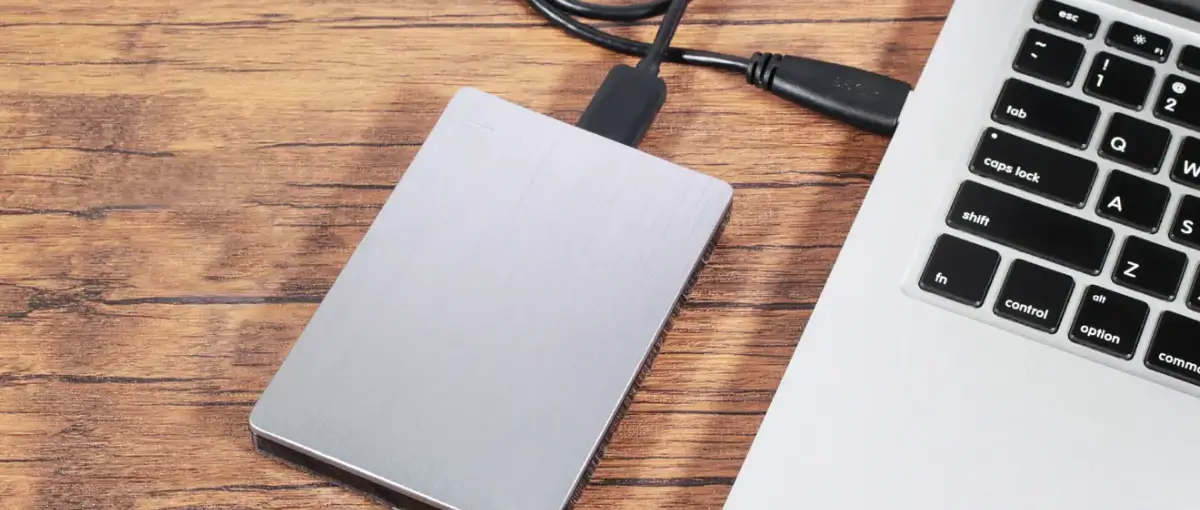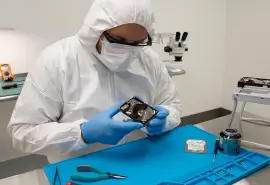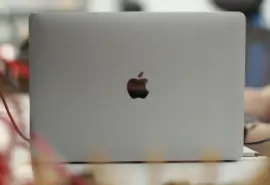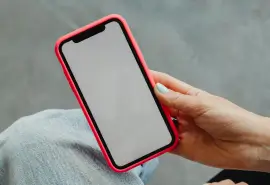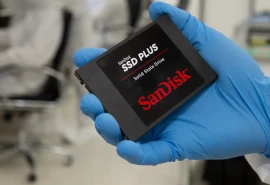Millions of Mac users depend on external hard drives for extra storage space and file transfers between computers. That crucial role can make losing access to your Mac external hard drive quite stressful.
But why is your external hard drive not showing up on Mac? And how do you best address the situation?
Secure Data Recovery is an Apple Authorized Service Provider (AASP). Below, our team of Apple Certified Mac Technicians (ACMT) explain the most common causes of detection problems. We also outline how to fix an external hard drive that will not show up on macOS.
Why Is My External Hard Drive Not Showing Up on Mac?
In most cases, external hard disk drives (HDDs) function without issue on Macs. You simply plug the external drive into your desktop or laptop and macOS opens Finder. From there, users can manage their devices within Apple’s file manager.
However, your Mac and external hard drive may fail to establish a connection on occasion.
These are the most likely reasons an external hard drive does not show up on Mac:
- Connection Issue: Frayed cables, damaged ports, and unstable power supplies could prevent access.
- Unsupported File System: macOS only reads or writes data formatted for specific file systems.
- Software Conflict: Third-party software, such as NTFS drivers or anti-virus tools, might interfere with the devices.
- Logical Error: Corrupted files, often caused by an unsafe ejection or power loss, can keep external hard drives from showing up.
- Hardware Failure: Sometimes, physical damage in the external drive could impede a connection between devices.
The solution for an undetected external drive depends on the diagnosis.
How To Fix Mac External Hard Drive Not Showing Up
Follow this step-by-step guide to restore access to an external hard drive on your Mac.
Note: Create another backup if the external drive stores important data. Consider using a data recovery service if the device contains essential files not saved elsewhere. Certified engineers and custom tools are the best chance to recover lost data.
Step 1: Check Connections
First things first: Make sure there is a reliable connection linking the external hard drive and Mac.
To check the cable, port, and power supply:
- Inspect the USB or Thunderbolt cable for signs of visible damage.
- Inspect the USB or Thunderbolt port for debris or dust.
- Ensure Low Power Mode is toggled off in Battery settings on MacBooks. The laptop might not provide sufficient power to the drive if enabled.
You can use different USB cables and ports to rule out defective connectors.
If the external hard drive seems securely connected to the Mac, then proceed to the next step.
Step 2: Find Out What macOS Sees
Apple’s System Information tool will show whether macOS detects the external drive.
To open System Information on macOS:
- Launch Finder.
- Go to Applications.
- Open the Utilities folder.
- Click System Information.
- Select USB (or Thunderbolt/USB4 if applicable) in the left sidebar.
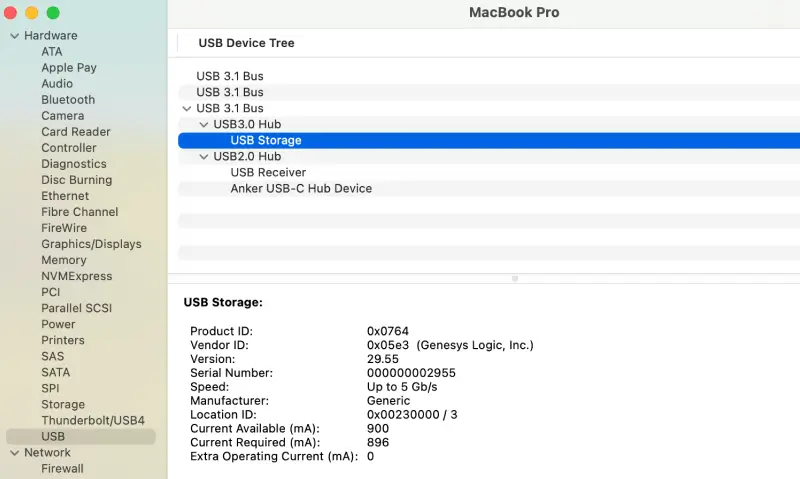
- Check the right pane for the connected external drive.
Your Mac may display the external drive in System Information even if the device is not visible in Finder.
Disk Utility can also provide helpful details for users to review.
To open Disk Utility on macOS:
- Launch Finder.
- Go to Applications.
- Open the Utilities folder.
- Click Disk Utility.
To see an external hard drive in Disk Utility:

- Click View in the toolbar.
- Choose Show All Devices.
A tree will appear in the left sidebar. It displays the storage layers of a Mac. The top level represents the actual hardware of the external drive. Lower layers handle logical pools, such as a container and volumes.
If macOS detects the drive, but containers and volumes are grayed out, then the issue likely resides within the file system. Proceed to Mount Volume with Disk Utility.
If macOS detects the drive, but does not show containers or volumes beneath it, then partition-map corruption is likely the issue. Proceed to Run First Aid.
If macOS does not detect the drive, then there is most likely an issue with the storage device itself. See the Test External Drive with Different Hardware and Seek Professional Assistance sections for further guidance.
Note: Activity Monitor, the macOS task manager, also offers clues. Processes like fsck_apfs, fsck_hfs, or fsck_exfat means the Mac is trying to repair file corruption.
Step 3: Mount Volume with Disk Utility
A faded HDD means the physical device is showing up in macOS. However, the Mac does not recognize its logical structure (file system).
To mount a volume in Disk Utility:
- Select the volume from the left sidebar.
- Click Mount in the toolbar.
Note: You must unlock the file system if the volume is using APFS Encrypted. Select the device and enter the password before mounting it.
This step attempts to connect the system and external hard drive for normal use.
Move onto Step 4 if the mounting process fails.
Step 4: Run First Aid
Corruption is possible when macOS detects a device, but not the drive’s container or volume. First Aid is a built-in tool for Macs to address corruption that prevents file access.
First Aid can sometimes lead to permanent data loss because it relocates or removes data stored in a damaged sector. Assess the value of the external drive’s contents before running First Aid. You may want to explore external hard drive recovery services if data loss is not an option.
For best results, run First Aid on the volume and then container. You can run First Aid on the device afterward if needed. This approach is safer and gives clearer signals because higher layers depend on the lower levels.
To run First Aid from the Disk Utility menu:
- Select the volume from the left sidebar.
- Click First Aid in the toolbar.

- Click Run.
- Select the container from the left sidebar if First Aid fails to repair the volume.
- Click First Aid in the toolbar.
- Click Run.
- Select the external drive from the left sidebar if First Aid fails to repair the container.
Proceed to Edit Finder Preferences if the repairs are successful. Otherwise, skip to Test External Drive with Different Hardware and Seek Professional Assistance.
Step 5: Edit Finder Preferences
You still may need to modify settings in Finder if First Aid reports that the file system was repaired.
To edit Finder settings to ensure macOS now displays external hard drives:

- Click Finder in the top-left corner of the screen.
- Choose Settings from the menu.

- Select Hard Disks and External Disks in the General tab.
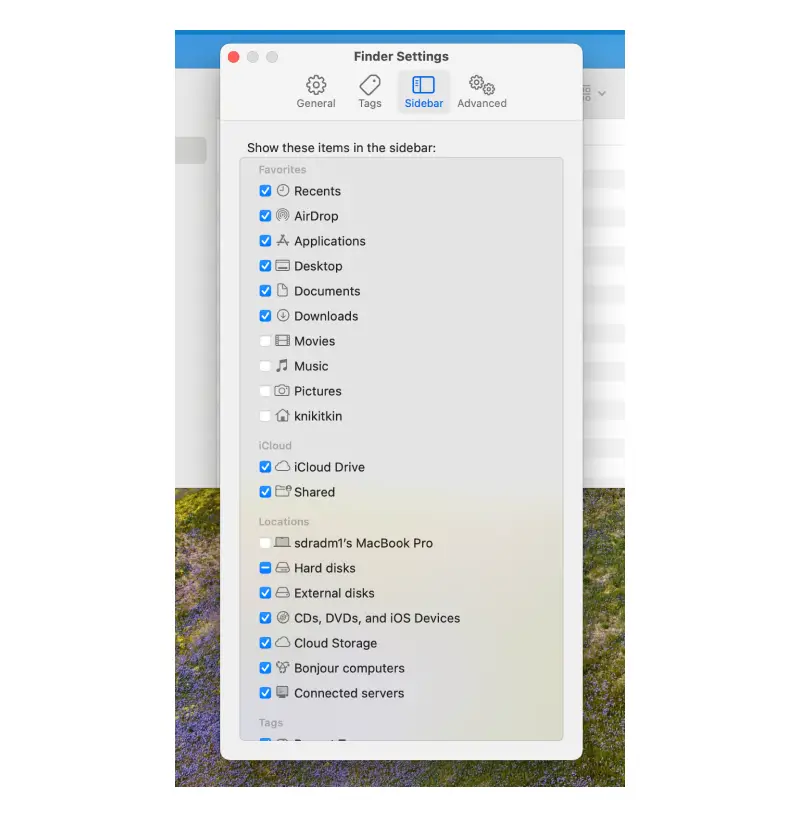
- Select Hard Disks and External Disks in the Sidebar tab.
Your external hard drive should now appear under Locations in Finder.
Step 6: Test External Drive with Different Hardware
Testing the external hard drive on another Mac or enclosure is worth a shot if it still is not visible.
Your external hard drive might not show up on your Mac due to a software conflict. Possible conflicts include an NTFS write driver or kernel extension. Some anti-virus tools scan the device before mounting it. That process may stall. Trying the drive on a separate system can help isolate the issue on the original Mac.
Also, some people choose to use an enclosure to expand their Mac’s storage space. It could lead to detection issues if the bridge controller in the enclosure encounters a problem.
If the external drive works on different hardware, boot the first Mac in Safe Mode and connect the device. You can create a disk image to preserve files or disable drivers in Safe Mode.
All hope is not lost if the external hard drive still does not appear.
Step 7: Seek Professional Assistance
Severe failures can happen to external hard drives. Some symptoms, such as hard drive clicking or beeping, are obvious. Other signs are more subtle. Regardless, a failed hard drive requires a skilled technician with specialized tools and techniques. DIY attempts at hard drive repair often worsen the situation.
A professional data recovery service is best equipped to retrieve data from a damaged hard drive.
Our Apple Certified Mac Technicians (ACMT) have decades of experience in hard drive recovery. That expertise involves restoring data on external hard drives that do not show up on Macs.
Call 800-388-1266, request help, or find a location to speak with a specialist and receive a free quote and No Data, No Recovery Fee guarantee.
Frequently Asked Questions
Why won’t my portable hard drive work on my Mac?
The most common causes for detection issues on Macs include:
- Damaged cables, ports, or enclosures
- Incompatible file systems
- Software conflicts
- Corrupted files
- Physical damage or mechanical wear
How do I fix a grayed-out hard drive on a Mac?
A grayed-out drive typically indicates file system issues. Fixing the underlying corruption often grants access to the external hard drive.
Can you recover data from an external hard drive that does not show up?
Yes. We have forensic-grade software to obtain low-level access to an unrecognized external drive. These methods allow us to extract data from a hard drive that does not show up and restore important files.
Can I format the Mac external drive?
You can also format your hard drive for Mac if Disk Utility detects the physical disk and you need the device right away. However, formatting the external hard drive will permanently erase data stored on the media. Proceed with caution.

